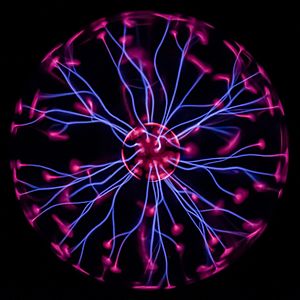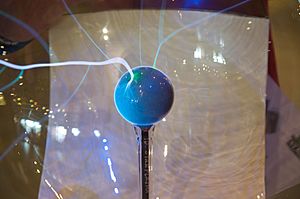Plasma globe facts for kids
A plasma globe or plasma lamp (also called plasma ball, dome, sphere, tube or orb, depending on shape) is a clear glass container filled with a mixture of various noble gases with a high-voltage electrode in the center of the container.
When voltage is applied, a plasma is formed within the container. Plasma filaments extend from the inner electrode to the outer glass insulator, giving the appearance of multiple constant beams of colored light.
Plasma globes were most popular as novelty items in the 1980s.
The plasma lamp was invented by Nikola Tesla, during his experimentation with high-frequency currents in an evacuated glass tube for the purpose of studying high voltage phenomena.
Tesla called his invention an "inert gas discharge tube". The modern plasma lamp design was subsequently developed by Bill Parker, a student at MIT.
Description
Although many variations exist, a plasma lamp is usually a clear glass sphere filled with a mixture of various gases (most commonly neon, sometimes with other noble gases such as argon, xenon and krypton) at nearly atmospheric pressure.
A crackle tube is a related device filled with phosphor-coated beads. Plasma lamps are driven by high-frequency (approximately 35 kHz) alternating current at 2–5 kV.
The drive circuit is essentially a specialized power inverter, in which current from a lower-voltage DC supply powers a high-frequency electronic oscillator circuit whose output is stepped up by a high-frequency, high-voltage transformer.
The radio-frequency energy from the transformer is transmitted into the gas within the globe through an electrode at its center.
Plasma filaments extend from the inner electrode to the outer glass insulator, giving the appearance of moving tendrils of colored light within the volume of the globe. If a hand is placed close to the globe it produces a faint smell of ozone, as the gas is produced by high voltage interaction with atmospheric oxygen.
Placing a finger tip on the glass creates an attractive spot for the energy to flow, because the conductive human body is more easily polarized than the dielectric material around the electrode. Therefore, the capacity of the large conducting body to accept radio frequency energy is greater than that of the surrounding air.
The energy available to the filaments of plasma within the globe will preferentially flow toward the better acceptor. This flow also causes a single filament, from the inner ball to the point of contact, to become brighter and thinner.
Much of the movement of the filaments is due to heating of the gas around the filament. When gas along the filament is heated, it becomes more buoyant and rises, carrying the filament with it.
An electric current is produced within any conductive object near the orb. The glass acts as a dielectric in a capacitor formed between the ionized gas and the hand.
History
In U.S. Patent 0,514,170 ("Incandescent Electric Light", 1894 February 6), Nikola Tesla describes a plasma lamp. This patent is for one of the first high-intensity discharge lamps.
Tesla used an incandescent-type lamp globe with a single internal conductive element and excited the element with high voltage currents from a Tesla coil, thus creating the brush discharge emanation. Tesla called this invention the single terminal lamp, or, later, the "Inert Gas Discharge Tube".
The Groundstar style of plasma globe was created by James Falk and marketed to collectors and science museums in the 1970s and 1980s.
The technology needed to formulate gas mixtures used in today's plasma spheres was not available to Tesla. Modern lamps typically use combinations of xenon, krypton and neon, although other gases can be used as well. These gas mixtures, along with different glass shapes and integrated-circuit-driven electronics, create the vivid colors, range of motions and complex patterns seen in today's plasma spheres.
See also
 In Spanish: Lámpara de plasma para niños
In Spanish: Lámpara de plasma para niños




